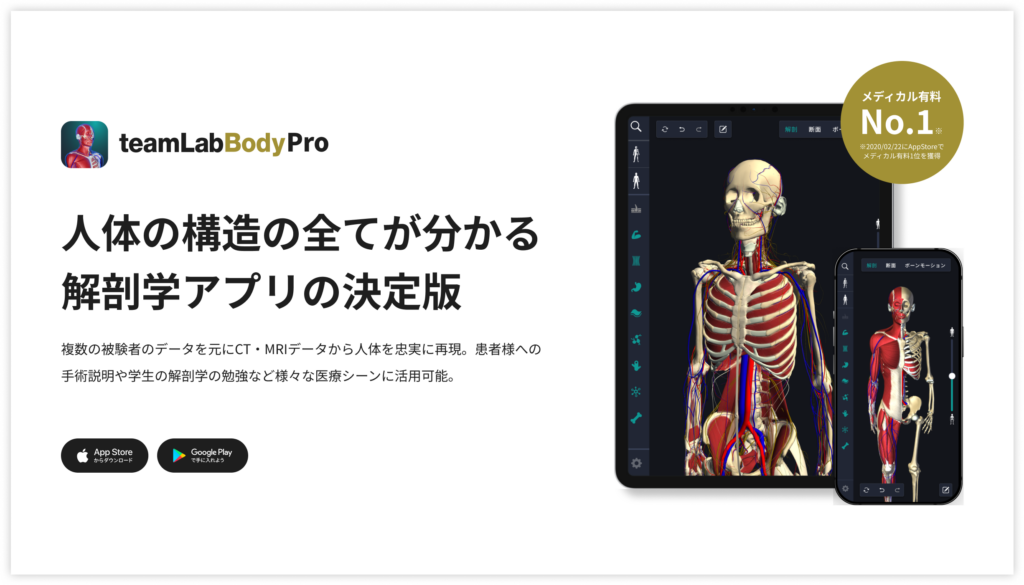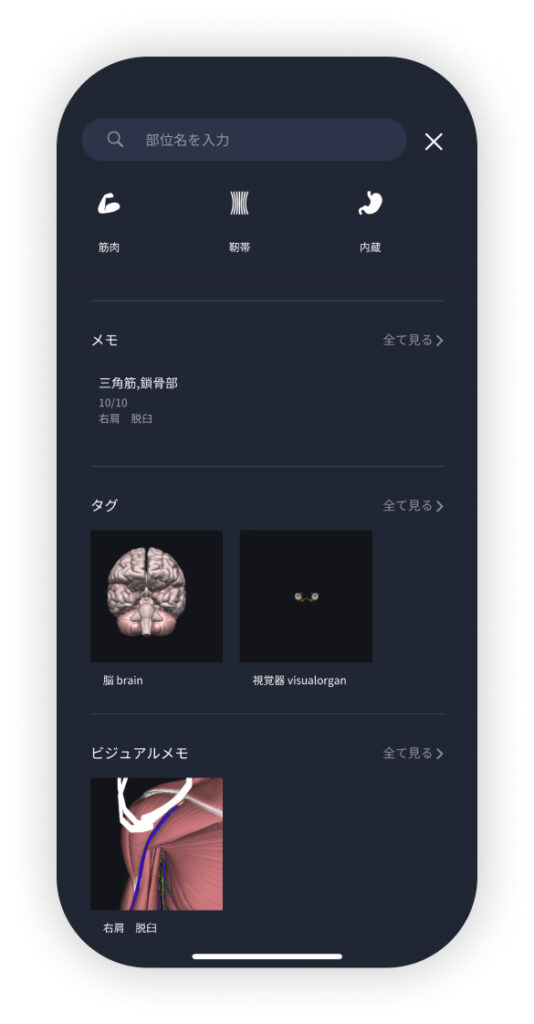beginning
In this article, I will explain effective study methods, starting with knowledge of specialized parts in human anatomy.
In human anatomy, it is necessary not only to memorize the names of various organs, muscles, and bones, but also to remember where they are located in the body. Therefore, it is necessary to learn as efficiently as possible.
I hope you will deepen your understanding even a little by reading this article and using the app.
Now, I'll explain the details about the “lateral ligament” and how to study human anatomy.
teamLab Body Pro Free Download
A 3D anatomy app that shows all the structures of the human body
Download teamLab Body Pro here!

What are lateral ligaments?
The anatomy application allows you to view a selection of anatomy 3D models. In this model, there are various observation methods such as surfaces, cross-sections, and nervous systems. This time, I'll explain using an anatomy application.
About lateral ligaments

The lateral ligament (lateral ligament) is one of the main ligaments for maintaining stability in joints, and its name and function vary depending on the part of the body.
A particularly representative one is the lateral ligament of the jaw joint (lateral ligament of temporomandibular joint), which runs from the joint nodule of the temporal bone to the neck of the mandible and has the function of preventing excessive backward movement of the jaw joint.
Also, the lateral collateral ligament (fibular collateral ligament) of the knee joint is also sometimes called the “lateral ligament,” and it runs from the outer epicondyle of the femur to the fibula head and contributes to stabilizing the knee joint against external stress. Both lateral ligaments restrict joint movement and play an important role in preventing trauma and dislocations, and are frequently mentioned in sports medicine and orthopedic fields. Since damage to the lateral ligament leads to joint instability and dysfunction, it is necessary to accurately understand the structure, movement, and function.
Study points
Anatomical understanding: accurately capture structure and positional relationships
The lateral ligament is a ligament located on the outside of the joint, and the name, shape, and function differ depending on the part. For example, the lateral ligament of the jaw joint runs from the temporal bone to the articular process of the mandible, and restricts excessive backward movement when opening and closing the jaw. In the knee joint, the lateral collateral ligament connects the femur to the fibula and provides stability so that the knee does not tilt excessively in the opposite direction. When learning, let's first clarify “which joint's lateral ligament is targeted” and check the relationship between start/stop and surrounding muscles and nerves with a 3D anatomy application or physical model. By visually understanding the positional relationship between bones and ligaments, it is easier to imagine the direction of restriction of joint movement and the effects of damage.
Functional understanding: learning in relation to movement
Since ligaments basically act as a “stopper that restricts movement,” it is important to be aware of which direction the joint moves and how that movement is controlled. Let's imagine how the lateral ligaments work in the temporomandibular joint when opening and closing the mouth, and during jumping and stepping movements in the knee joint. In particular, by confirming the movement of the lateral collateral ligament tension with your own body while reproducing external stress on the knee, the image of movement restrictions becomes clear.
Practical application: deepening from clinical relationships
In clinical practice, damage to the lateral ligament is observed in many cases. For example, if the knee joint moves excessively in the opposite direction due to contact sports or falls, etc., the lateral collateral ligament is damaged, causing knee instability and pain. Similarly, in the temporomandibular joint, relaxation and inflammation of the lateral ligaments may be a problem in connection with habitual dislocation of the jaw joint or TMJ joint disease. In the field of diagnosis and treatment, it is necessary to comprehensively evaluate the extent of ligament damage, joint range of motion restrictions, relationships with surrounding tissues, etc., so learning as a connection between structure and function is required rather than simply memorizing names.
How to study human anatomy
I will explain specific study methods using human anatomy applications.
Check your past learning history and practice repeatedly
Here are the steps to check your anatomy learning history and practice iteratively effectively.
1. Check your learning history in the app
Reviewing your learning history with the application is an important step in effectively advancing anatomy learning. First, launch the app and go to the learning history section from the main menu. Many anatomy apps are designed to show your progress in the form of graphs and lists, so you can visually check which parts you've learned about and how much time you've spent.
By using this data, you can understand which areas you have strengths in and where you need to spend more time and effort. We also recommend using a dedicated tag or notebook function to mark areas you are particularly weak at or where you need to relearn. Regularly checking your learning history and looking back on past learning content will lead to efficient review and deepening understanding.
2.Make a plan for iterative learning
Making an efficient repetitive learning plan based on learning history is extremely effective in promoting knowledge retention. First, identify weak points and areas where you need to relearn. Next, arrange these study items into a weekly or monthly calendar and create a specific study schedule. By proceeding in a planned manner, you can learn each part evenly and avoid packing in a large amount of information at once.
Using a task management app or digital calendar to set study reminders is effective. Also, it's important to have the flexibility to regularly review progress and revise plans as needed. By having goals and proceeding with your studies in a planned manner, you can efficiently acquire anatomical knowledge.
3.Use 3D features to learn visually
By utilizing the 3D function, learning anatomy is easier to understand visually. The 3D model shows the structure of the human body three-dimensionally, and each part can be observed in detail. This makes it possible to intuitively grasp positional relationships between deep muscles and organs that are difficult to capture in a planar view. For example, you can learn even the smallest details by rotating specific muscles and bones and zooming in and out.
Also, there are many apps that have the function of displaying cross-sectional views of each part using a 3D model, which is useful for deepening understanding of internal structures. This diversity of visual information helps with memory retention and improves immediate responsiveness in tests and practice situations. By utilizing the 3D function and learning visually, you can learn anatomy knowledge more deeply and efficiently.
Use the memo function concretely

Make notes so you don't forget the things and points you've noticed while studying. The memo function can be used for different purposes, such as inputting text, saving images, and writing memos. Tag your notes to make them easier to review later.
Test your learning regularly in the form of quizzes
Regularly testing what you've learned in a quiz format is a very effective way to anchor your anatomy knowledge. Quiz-style tests help you objectively grasp your level of understanding and areas you lack while repeating knowledge.
For example, by using a learning app to conduct quizzes every specific period, you can reconfirm what you've learned and strengthen your memory. There are a wide range of quiz formats, such as multiple choice questions, fill-in-the-blank questions, and short answer questions, and each helps understanding from a different angle and develops the ability to utilize various types of knowledge.
Get feedback
If possible, get feedback from other learners and experts. It helps you find your own gaps in understanding and areas for improvement. You can also keep yourself motivated to learn by regularly testing yourself. Feeling a sense of accomplishment and progress increases motivation for continuous learning.
summary
This time, I explained how to study “lateral ligaments” using an application!
Thank you for reading this far.
I would be happy if reading this article helped you learn about anatomy.
Learning is a long, never-ending journey, but I sincerely wish you all the best. Let's continue to study together and work hard for the national exam!
Please look forward to the next blog.
teamLab Body Pro Free Download
A 3D anatomy app that shows all the structures of the human body
Download teamLab Body Pro here!





